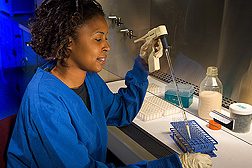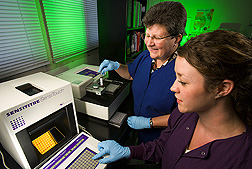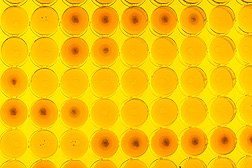Food Safety in the 21st Century
Coordinated Monitoring of Animal Health
Food safety doesn’t begin at the grocery store; it begins at the farm.
In 2003, the Agricultural Research Service (ARS) and two other U.S. Department of Agriculture (USDA) agencies launched a joint effort to better protect the health of America’s livestock and ensure the safety of America’s food supply.
This research endeavor—called the “Collaboration in Animal Health and Food Safety Epidemiology” or CAHFSE (pronounced “calves”)—provides a means to routinely track critical diseases in food-animal production and enhance overall understanding of bacteria that pose food-safety risks on farms and in processing plants. CAHFSE was designed to enhance two existing USDA programs that periodically assess farm-animal health and antimicrobial resistance: the National Animal Health Monitoring System (NAHMS) and the National Antimicrobial Resistance Monitoring System (NARMS).
NAHMS conducts surveillance on a selected meat or poultry commodity once every 5 years, seeking to identify and address animal health and food safety issues of major concern. NARMS monitors changes in antimicrobial susceptibility patterns in zoonotic bacteria (those that can transmit diseases from lower animals to humans) and in commensal bacteria (those that live within livestock or humans without making them sick). While both programs are critical to food safety, the key to CAHFSE is the continual risk analysis conducted by USDA on the farm and in the plant.
The infrequent or passive sampling under NAHMS and NARMS has limited their capacity to make significant positive changes in the short term. “Now, by gathering data in an ongoing, consistent fashion, CAHFSE is building on the strength of both programs,” says Paula Fedorka-Cray, research leader of the ARS Bacterial Epidemiology and Antimicrobial Resistance Research Unit in Athens, Georgia. She also heads the ARS CAHFSE effort. “NAHMS and NARMS provide separate snapshots in time of animal health and antimicrobial-resistant pathogens,” she says. “CAHFSE surpasses those programs by providing epidemiological profiles from farm to fork. In other words, we aim for the big picture with regard to microbial contamination of meat animals.”
CAHFSE is currently a joint effort of three USDA agencies: ARS, the Animal and Plant Health Inspection Service (APHIS), and the Food Safety and Inspection Service (FSIS). Over time, the program will expand to include other agencies and groups.
The Big Picture’s a Tall Order
Despite significant producer interventions, ongoing research efforts, and regular surveillance, outbreaks of foodborne illnesses continue to occur. And the emergence of foodborne bacteria that are resistant to multiple antimicrobial treatments has amplified public concern. The market hog industry has shown dramatic improvement in meeting Salmonella performance standards since they were implemented in 1998. In that first year about 65 percent of samples passed the performance standards. By 2005, more than 90 percent met those standards. But there is still room for improvement.
Gathering as much information as possible about foodborne pathogens will allow researchers and industry to determine what happens throughout the production-processing continuum. “We need to find out which pathogens are moving from the farm to the processor and then on to retail,” says Fedorka-Cray.
A detailed sampling, testing, and analytical protocol is being followed to determine the on-farm and in-plant prevalence of Salmonella, Campylobacter, Escherichia coli, and Enterococcus bacteria. Though this is a tall order, Fedorka-Cray says that CAHFSE will enhance and expand projects already directed at animal-health and antimicrobial-resistance issues. It will help USDA reliably track emerging animal diseases within food animal populations.
“Because pathogens are fluid over time, we need to gather information over a long period—and across the production spectrum—to find out the impact any particular change in animal health issues or plant operations will have,” says Fedorka-Cray.
The first food animal selected for CAHFSE examination was swine. “Gathering management information will allow those responsible for raising and processing swine to make decisions based on a wealth of historical data—even if it’s recent history,” she says.
The choice of pork was good news for pork producers, according to Paul Sundberg, vice president of science and technology for the National Pork Board (NPB). “The pork industry has long based its policies and programs on the best scientific data available,” he says. “CAHFSE provides the means to gather information—in a scientific manner—on antibiotics and antibiotic resistance and to find out if and how they are related.”
Linking Farms to Processors
Creating that data history began with obtaining samples from swine farms. In the first 2-year CAHFSE cycle, 48 farms in 5 states participated. Those vital samples were collected by field veterinarians with APHIS or state agricultural departments and sent to Fedorka-Cray’s unit for analysis.
FSIS provided funding for a pilot study in pork-processing plants and sent samples to Athens for analysis. “It’s important to compare microbial data from both the farms and the processing plants to determine the impact each has on movement of pathogens,” says Fedorka-Cray. “The data can also give information about the effects of plant operating speeds and temperatures on pathogen occurrence in swine.
|
|
“So far, the data show how variable results can be over time, which highlights the importance of a continual presence on the farm and in the plant. For example, there are regional, seasonal, and farm effects in play. Sampling only one time, as many studies do, only gives us a snapshot of events. CAHFSE gives us a history of events. One other thing that certainly stands out is that resistance to antibiotics seems to be serotype-dependent. In other words, not all types of Salmonella become resistant to antibiotics the same way. Some serotypes will be resistant to one antibiotic and not another. This makes studying antibiotic resistance very complicated.”
“The pork industry has a program called ‘Take Care,’ which focuses on the industry’s responsible use of animal health products, like antibiotics,” says NPB’s Sundberg. “CAHFSE is gathering information that will help support our policies and needs.”
“This is what CAHFSE is all about,” says Fedorka-Cray. “We’re putting together a national system that will meet the changing needs of the industry.”
CAHFSE data is summarized and results are publicly available at www.aphis.usda.gov/cahfse/index.htm.—By Sharon Durham, Agricultural Research Service Information Staff.
This research is part of Food Safety, an ARS National Program (#108) described on the World Wide Web at www.nps.ars.usda.gov.
Paula Fedorka-Cray is in the USDA-ARS Bacterial Epidemiology and Antimicrobial Resistance Research Unit, Richard B. Russell Research Center, 950 College Station Rd., Athens, GA 30605-2720; phone (706) 546-3685, fax (706) 546-3066.
"Food Safety in the 21st Century" was published in the October 2006 issue of Agricultural Research magazine.










